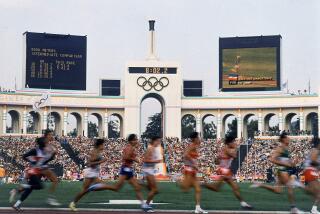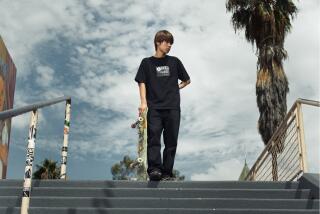For Rollerblade Inc., Success Was Uphill Battle : Recreation: With a small budget and even smaller staff, marketing whiz Mary Horwath had to resort to some creative ploys to popularize both the sport and the firm.
NEW YORK â Spring is in the air, and millions of Americans are lacing up their roller-blades.
Skaters have been sprouting like the crocuses in Manhattanâs Central Park, where hundreds of bladers come on Sunday afternoons to slalom through obstacle courses, dance to boomboxes or otherwise play on the hardtop.
Thatâs no small accomplishment for Rollerblade Inc., which gave the sport its name by pioneering the in-line skate in 1984. The private company doesnât release sales figures, but one estimate last year put consumer sales of roller-blades in the hundreds of millions of dollars.
Credit much of this work to Mary Horwath, a 34-year-old marketing whiz who came to the company in 1986 from the U.S. Freestyle Ski Team with a tough assignment: Make Rollerblade grow.
Her budget: $200,000. Her staff: two, including herself.
The task was especially daunting because few people knew what in-line skating was, let alone Rollerblade. The only people who owned the skates with plastic wheels were professional hockey players and ski racers.
Horwath accepted the challenge, and her work is a textbook study in how to succeed in business without really having the money.
âWe depended primarily on some creative grass-roots activities that might generate larger exposure than just something local,â said Horwath, vice president of marketing, from company headquarters in Minnetonka, Minn.
First Rollerblade gave skates to just about anyone famous who would use them--âgosh, hundreds of people,â Horwath said, âfrom the New York Jets to Michael Keating to Rick Moranis to Janet Jackson to Richard Dean Anderson to a variety of people across the map.â
The company learned that Los Angeles Kings star Luc Robitaille liked to train on roller-blades. âWe immediately called him and started sending him skates and made (the relationship) a little more official,â Horwath said. The deal included Robitailleâs appearance in Rollerblade ads and events.
Someone from the company saw John Kennedy Jr. wearing roller-blades in People magazine, so Rollerblade sent him skates, hoping heâd stay loyal.
The company also revved up demonstration vans to tour city parks, events and anywhere else people could be coaxed into a free skate--lessons and protective equipment included. The company formed Team Rollerblade, professional skaters who wow spectators with their âbladingâ skills.
Rollerblade got even more publicity by hooking up with other companies. It started in 1987 when General Mills approached Rollerblade for a joint promotion sweepstakes with its Golden Grahams cereal. Now roller-blades can be seen in commercials for McDonaldâs, Diet Mountain Dew, Coors and Kodak.
If imitation is the greatest form of flattery, Rollerblade should be beet-red. Thirty other companies are now making in-line skates and fighting for a piece of Rollerbladeâs dominant market share.
Now Rollerblade--and Horwath--must position the product and out-skate the competition, which includes Bauer, the brand worn by a majority of players in the National Hockey League.
The company has been âlooking for new opportunities to build better products, expand the market in general and put the best quality product out there,â Horwath said.
For one, Rollerblade has come out with its own line of sportswear. It doesnât hurt to be half-owned by ski-boot maker Nordica, which also makes apparel and is owned by clothing giant Benetton.
Rollerblade has licensed its name to toy maker Mattel for a Rollerblade Barbie. The doll will be advertised on childrenâs television shows this spring.
More to Read
Inside the business of entertainment
The Wide Shot brings you news, analysis and insights on everything from streaming wars to production â and what it all means for the future.
You may occasionally receive promotional content from the Los Angeles Times.










